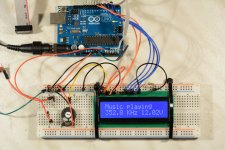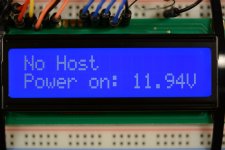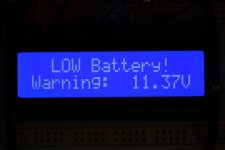So, for a 4 deck DAC he would have bought 16 regs at 37 euros each? Outch!
Do
Hi Do,
See post 259 in this thread for some pictures of earlier two boards. Now running with four boards and 16 shunts. So upgrading to eight boards will drain my wallet tooooooooo much.
I think the sound improvement justifies the costs of the shunts, also if you order bigger amounts at tentlabs they will give you a nice discount.
Regards,
Regards,
See post 259 in this thread for some pictures of earlier two boards. Now running with four boards and 16 shunts. So upgrading to eight boards will drain my wallet tooooooooo much.
I think the sound improvement justifies the costs of the shunts, also if you order bigger amounts at tentlabs they will give you a nice discount.
Regards,
Regards,
dddac, I see that you are experimenting with 8 deck tower on DDDAC1794 NOS.
How does it compare with a 4 deck version?
Thanks
Do
again another step in more detail, more spatial soundstage and dynamics. Again mo analogue sound...
the step is smaller than from one deck to four decks.
again another step in more detail, more spatial soundstage and dynamics. Again mo analogue sound...
the step is smaller than from one deck to four decks.
Good to know.
Same type of improvements than with the change to shunts, only difference with shunts is much bigger than the move from one to four decks. so I do not have to drain my wallet with anorher four shunted boards 🙄
Regards,
Two developments yesterday:
Firstly Ians1 kindly brought his DDDAC which has 4 boards and Mundorf caps, to compare with my single board and standard caps version. We had a good listen and I think the conclusion was the 4 board was better, maybe not by an awful lot, but did seem to have a little more across the frequency range, and a noticeable increase in space/ air.
This was really helpful in concluding which direction to take my DDDAC, and it looks like inspired by some of the great posts on here that rather than go for an extra 3 boards we'll be looking at a single board with shunt regs and Rhopoint IVs.
Secondly, I finally got around to fitting XLR connectors to my DDDAC. The purpose being that all reviews point towards my preamp performing much better in all balanced mode.I left the RCA outputs in place and wired in the XLR chassis by jumping from the RCA with a new wire neg to neg from the board.
The improvement was immediate! Hard to be totally precise about these things, but the effect is an increase in the illusion of depth, and just a little bit more 'zing' - which I can translate as a touch more dynamics with cleaner top end!
Obviously this is an improvement borne of the preamp rather than the DDDAC. Like a lot of changes/ findings they are relative to the kit we have, so for reference my current set up is:
Mac Mini (+Audirvana) - DDDAC - Ayre K-5xemp - Event Opal active monitors
Firstly Ians1 kindly brought his DDDAC which has 4 boards and Mundorf caps, to compare with my single board and standard caps version. We had a good listen and I think the conclusion was the 4 board was better, maybe not by an awful lot, but did seem to have a little more across the frequency range, and a noticeable increase in space/ air.
This was really helpful in concluding which direction to take my DDDAC, and it looks like inspired by some of the great posts on here that rather than go for an extra 3 boards we'll be looking at a single board with shunt regs and Rhopoint IVs.
Secondly, I finally got around to fitting XLR connectors to my DDDAC. The purpose being that all reviews point towards my preamp performing much better in all balanced mode.I left the RCA outputs in place and wired in the XLR chassis by jumping from the RCA with a new wire neg to neg from the board.
The improvement was immediate! Hard to be totally precise about these things, but the effect is an increase in the illusion of depth, and just a little bit more 'zing' - which I can translate as a touch more dynamics with cleaner top end!
Obviously this is an improvement borne of the preamp rather than the DDDAC. Like a lot of changes/ findings they are relative to the kit we have, so for reference my current set up is:
Mac Mini (+Audirvana) - DDDAC - Ayre K-5xemp - Event Opal active monitors
..........rather than go for an extra 3 boards we'll be looking at a single board with shunt regs and Rhopoint IVs.
........I finally got around to fitting XLR connectors to my DDDAC.......
The improvement was immediate! Hard to be totally precise about these things, but the effect is an increase in the illusion of depth, and just a little bit more 'zing' - which I can translate as a touch more dynamics with cleaner top end!
Obviously this is an improvement borne of the preamp rather than the DDDAC.
We have a believer!! 😛 You are right; shunts make sense, but why not go all the way and also build a Salas shunt regulator? 🙄
Balanced is also good, however the improvement is not so much due to your amp as you say; I noticed same improvements but my setup is with a totally Single Ended amp which has transformer inputs. Improvements come from the balanced DAC outputs and LESS components between DAC and Amp.
I also like Tantalum resistors very much, you might try them as IV resistors.
Indeed interesting developments... Dick van de Merwe is also thinking in that direction, that using the extra double DACs plus the balanced way of getting out, is a large part of the "seret" why it sounds better at balanced outputs
read here : Dick's article on DDDAC1794 8 decks version
By the way, today I did some measurements on a single Deck DDDAC1794 at the balanced Output. See Image 😎
As you can see linearity at 24 bits is very good and Ends up in the deep noise Levels of the measurement Setup 😱
Also interesting the 16 bit line, showing that dynamic range is clearly limited 🙄
enough smilies for now ... 😛
doede
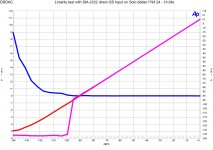
PS: the same, but now as "Sweep" using real bit steps... showing how the lowest bits are going under. (Wanna start a thread why we see DACs these days with 32 bit ?)
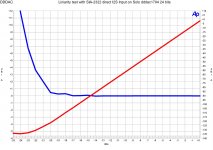
read here : Dick's article on DDDAC1794 8 decks version
By the way, today I did some measurements on a single Deck DDDAC1794 at the balanced Output. See Image 😎
As you can see linearity at 24 bits is very good and Ends up in the deep noise Levels of the measurement Setup 😱
Also interesting the 16 bit line, showing that dynamic range is clearly limited 🙄
enough smilies for now ... 😛
doede

PS: the same, but now as "Sweep" using real bit steps... showing how the lowest bits are going under. (Wanna start a thread why we see DACs these days with 32 bit ?)

Hi,
A very good story of dick's 8 deck dddac 1794. Too his explanation of the Sowter output trafo's.
The next is just for clearity.
This night I reread the 1794 datasheet, on the first page "dynamic range:132 dB (9 volt rms, mono)".
9 volt rms ??? Here is something what I not understand. Is there anyone who can explain this?
Thanks a lot.
Regards,
Zjaakco
A very good story of dick's 8 deck dddac 1794. Too his explanation of the Sowter output trafo's.
The next is just for clearity.
This night I reread the 1794 datasheet, on the first page "dynamic range:132 dB (9 volt rms, mono)".
9 volt rms ??? Here is something what I not understand. Is there anyone who can explain this?
Thanks a lot.
Regards,
Zjaakco
Last edited:
page 21... and than balanced. That is with all the opamp stuf after it.
and that is dynamic range no mention how linear that is 🙂
and that is dynamic range no mention how linear that is 🙂
Hi Doede,
will the change from 3,3v to 5v for the supply of the motherboard also benefit when using 4 boards?
How much current will the motherboard draw?
Regards,
will the change from 3,3v to 5v for the supply of the motherboard also benefit when using 4 boards?
How much current will the motherboard draw?
Regards,
Not sure if it will be that audible... of course you can run any nr of boards with the 5 volt supply. supply current for the main board is roughly 110 - 130 mA, depending on the sample frequency and nr of LEDs "on"
I made my test board now with a red LED between common and GND ( parallel 1 uF ) and make it selectable with a switch. no time to seriously listen so far....
I made my test board now with a red LED between common and GND ( parallel 1 uF ) and make it selectable with a switch. no time to seriously listen so far....
very good work,
I understand how to bypass internal filter, but it only accept 24 bits right justified format, if I only have 16 bits data, can tell me how to config pcm1794 so it can accept 16 bits data, read from pcm1792 datasheet, it is very clear, we can bypass internal filter and choose 16 bits 20 bits and 24 bits
I understand how to bypass internal filter, but it only accept 24 bits right justified format, if I only have 16 bits data, can tell me how to config pcm1794 so it can accept 16 bits data, read from pcm1792 datasheet, it is very clear, we can bypass internal filter and choose 16 bits 20 bits and 24 bits
very good work,
I understand how to bypass internal filter, but it only accept 24 bits right justified format, if I only have 16 bits data, can tell me how to config pcm1794 so it can accept 16 bits data, read from pcm1792 datasheet, it is very clear, we can bypass internal filter and choose 16 bits 20 bits and 24 bits
16 bits data or 24 bit data does not matter. wat matters is that you adapt to the dac chip set up. in This case 24 bit, so you know how many clockcycles you need to delay... for the circuit, see my website, it is all there..
LCD panel for WaveIO
Just for fun, I worked out a LCD message indicator for the WaveIO Board. It can be used with the DDDAC, but of course with any other WaveIO as well... 🙄
It is based on an Arduino UNO and 16x2 dot matrix display.
You can find it all on my Website under "other projects" (code included)
click here to go the LCD Project page
and... here are a few teasure pictures 😀
Just for fun, I worked out a LCD message indicator for the WaveIO Board. It can be used with the DDDAC, but of course with any other WaveIO as well... 🙄
It is based on an Arduino UNO and 16x2 dot matrix display.
You can find it all on my Website under "other projects" (code included)
click here to go the LCD Project page
and... here are a few teasure pictures 😀
Attachments
Uh Oh ! I have a calling telling me to get 4 more Dac boards. I must resist. I must resist.
You shall not resist! Such a thing will only get worse. You shall have nightmares about it, stop eating and your thirst for DIY will grow even bigger!

Do. 😀
I cannot resist any longer, I will order some more boards later in the week.
Would it be better also to get another mother board with the 5v regulator.
Will i need a more powerful 12v power supply to run them.
The IV resistors will be 16.75 Ohm, and I guess I will need the Sowter 3575`s with the OCC wire.
I will need a taller case as well .....
Would it be better also to get another mother board with the 5v regulator.
Will i need a more powerful 12v power supply to run them.
The IV resistors will be 16.75 Ohm, and I guess I will need the Sowter 3575`s with the OCC wire.
I will need a taller case as well .....
I cannot resist any longer, I will order some more boards later in the week.
Would it be better also to get another mother board with the 5v regulator.
Will i need a more powerful 12v power supply to run them.
The IV resistors will be 16.75 Ohm, and I guess I will need the Sowter 3575`s with the OCC wire.
I will need a taller case as well .....
Look forward to your order 🙂
I can send for free the 5 Volt Regulator with the boards, so you can change it against the 3V3 one...
If you have the dddac power supply (12V) it can feed 8 boards without any Problem...
A taller case, yes, can't help 😀
- Home
- Source & Line
- Digital Line Level
- A NOS 192/24 DAC with the PCM1794 (and WaveIO USB input)

